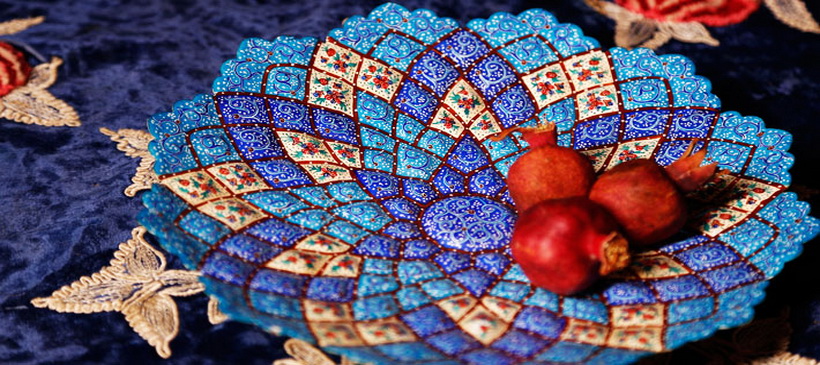Minakari

Ghalamkar
March 21, 2017
Termeh
March 21, 2017Minakari
Minakari, or enameling, is the Persian art of painting, coloring, and decorating metal surfaces by fusing them with vibrant colors in intricate designs. The term “Mina” comes from the Persian word “Minoo,” meaning heaven, reflecting the azure blue of the skies.
This ancient art was pioneered by Iranian craftsmen during the Sasanid era and later spread by the Mongols to India and beyond. French traveler Jean Chardin noted exquisite enamel works from Isfahan featuring birds and animals on floral backgrounds in various colors.
Painting with magic colors. These colors attained from the following chemicals:
- A white glaze: Tin, lead crystal, flint
- Yellow: Iron oxide, tin oxide and lead oxide
- Turquoise color: Tin, lead crystal, flint, copper shingle
- Black: Iron oxide, manganese dioxide, lead, cobalt oxide
- Blue: Cobalt oxide, zinc oxide, flint
- Brown: Chromium oxide green, iron oxide, zinc oxide
- Green: Copper shingle, flint glass (stone), lead chromate
- Red violet: Crystal, ammonium nitrate, and dissolved gold
Process of Making
After a period of stagnation since 1992, the art of Minakari has experienced a revival, with numerous distinguished artists now bringing this traditional craft back to life. To create an enameled dish, the process begins with selecting and shaping a metal substrate, typically copper, due to its malleability and flexibility. Historically, materials like tile, ceramic, and glass were also used. The metal is then coated with a white glaze using a dipping technique and heated at 750°C. This process is repeated three to four times to achieve the desired finish. The enamel glaze, composed of a blend of materials including silicon, magnesium, potassium, and precious stones, is meticulously applied to ensure a vibrant and durable design.
Once the base is prepared, skilled artists hand-paint intricate designs onto the surface, often featuring motifs inspired by nature, such as flowers, birds, and geometric patterns. These designs are then fired in a kiln to fuse the colors and create a brilliant, lasting finish. The final product is a stunning piece of art that reflects the rich cultural heritage of Iran, blending tradition with modern artistic expression.
Today, Minakari is not only cherished in Iran but is also gaining international recognition as a symbol of Persian craftsmanship, with these exquisite enamel pieces being sought after by collectors and art enthusiasts worldwide.

